

LOCAL COLOR
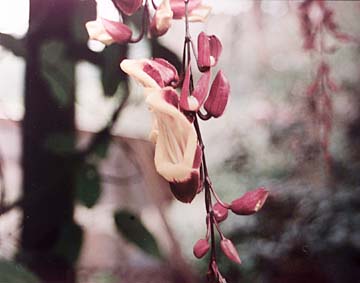
Jensen Okimoto snapped "Hanging Yellow Flower," above, because "it had my favorite colors -- yellow and red -- and it looked like a slipper." The photography bug having bitten him hard, Jensen "shoots everything. If I go bowling and I get a strike, I take a picture of it. When I go on vacation, I take pictures of all the fun stuff." Aida Okimoto said her son enjoyed himself so much during the "Art in Nature's Garden" program, "now he wants to be a photographer." He's gotten a head start using the Pokemon camera he bought from a book club at school. Jensen attends Manoa School.
In quiet, lush Manoa Valley, second-grade public school teachers Janice Nishiki and Lori Chun are fighting the good fight -- and winning. Learning nature through a lens
Second-graders at Manoa and Noelani
schools display their garden photographsFlower photography broadens
horizons for 7-year-old Manoa girljoleen oshiro
joshiro@starbulletin.com
Their most recent trophies are 40 nature photographs, taken by second-graders at Manoa and Noelani elementary schools, on display at the Canon Gallery. The exhibit, titled "Art in Nature's Garden," takes its name from the environmental education project the teachers designed several years ago, in which a field trip to Lyon Arboretum integrates lessons of science, art, language arts and social studies.

Second-grader Jolie Kawasaki snapped this photo, which she titled "Peek-a-Boo," at Lyon Arboretum during a class excursion that teaches students about environmentalism.
"The overall focus of the second-grade curriculum at our schools is community," said Chun, who teaches at Manoa School. "And here were these kids, living and being schooled in the valley, and many of them didn't even know the arboretum was there."
In fact, the nature site is just a mile or so away from the schools, so Chun and Nishiki incorporated the arboretum into their project.

Matthew's classmate, Alexander Maron, took a close-up of a cactus and called it "Sparkle." "It was a pretty good picture," he said. "There were different shades of green and blue, colors that are alive, and texture." At home, Alexander takes pictures with his Pokemon camera, which he ordered from a cereal box.
The teachers had discovered the educational resources at the arboretum when they began teaching there a few summers before "Art in Nature's Garden" was conceived.
"It was like we found a secret garden," said Nishiki, a Noelani teacher. "It's a beautiful place of nature, and we began to realize what a wonderful place it is for children to learn. If there's a concept you want to teach, it's happening right there. The children can see a bee pollinating a flower in front of their eyes."
So the duo applied for a grant from the Hawaii Public Schools Foundation to create the program. Their "big idea" in the proposal, Nishiki said, asked, "Can the beauty of nature be captured by students? Can they then become better stewards of our environment?" Chun and Nishiki got their grant and were awarded $1,500 to start the project.
The teachers originally wanted students to paint watercolors of the plants during the excursion, but realized that would not be the most effective use of their time. They decided instead that students should take pictures of the plants and paint a replica of the photographic images later, in the classroom. So in that first year they bought two Canon cameras and worked with arboretum photographer Greg Clark to teach the students how to shoot.

Joshua's picture is Matthew Ohtani's "Harmony Tree." "I took the picture because there's lots of texture and it was a little picture," Matthew said. "I like to capture little things." Matthew also attends Noelani.
"Greg came to us and showed the children how a photographer's eye can capture nature," Nishiki said. The teachers instructed the students on applying elements of art, such as line, color, shape, texture and space.
In the classroom the students also produced leaf collages and learned about leaf patterns, venations and leaf classifications, studying art and science. And they wrote poetry based on their encounter with nature, to strengthen their language capabilities.
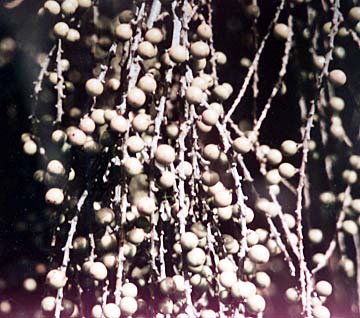
Joshua Ko, of Noelani, called his nature photograph "The Beads."
When Clark saw the quality of the students' photographs, he suggested staging an exhibition of their work. Jill Laughlin, keeper of Lyon Arboretum's education programs, held the exhibit at the arboretum and invited Canon President Hirohisa Asari to the opening. Impressed, Asari left promising a donation of more Canon cameras and an exhibit at the Canon Gallery.
When: Through June 30 "ART IN NATURE'S GARDEN"
Where: Canon Gallery at Ward Plaza, 210 Ward Ave., Suite 200
Hours: 9 a.m. to 5 p.m. Monday through Friday
Call: 522-5930
When the exhibit came to fruition this year, it was a thrill for students and their families to see their work up in a formal exhibit, the photographs matted and mounted behind glass.
"The whole approach is experiential," Chun said. "The children go there and take everything in. They're just immersed. They take in the sights and sounds of nature and respond with their artwork and poetry.
"In capturing those moments and remembering them, we hope the students will see the beauty in nature and realize that if they want to keep it, they must take care of it."
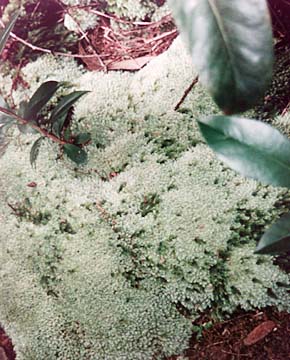
Manoa student Troy Anderson captured the beauty of "Green Moss."
CHUN AND NISHIKI met about six years ago, at a meeting for teachers in their district to devise what became the Harbors Project, curricula that address the areas in Honolulu from the mountain to the harbor. The project links students from kindergarten through grade 12 and offers lessons on various subject "strands," such as history strands, cultural strands and environmental strands. The two women developed a reef walk for their second-graders that today is overseen by Steven Takata, a Roosevelt High School marine biology teacher, and his students.
"We meet the Roosevelt students at the tide pools, where we can see the animals in their environment. They teach us by presenting hands-on, interactive lessons to learn about marine life," Nishiki said. "They are our mentors. They take care of the children, show them things in the water and teach them how to take care of the environment. It becomes very meaningful for the children."
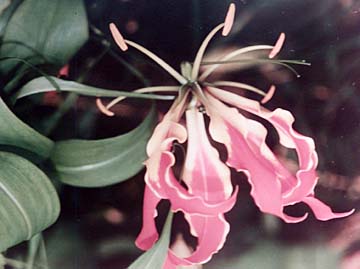
Fellow Manoa student Erin Yamashita, who took "Red Hanging Lily," said, "It was more fun to go to the garden than read about it."
The Reef Walk project became inspiration for Chun and Nishiki to create more project-based lessons for their students. The teachers came upon the idea of using the arboretum as part of a project after they were invited to teach there by Laughlin, whose daughter was in Nishiki's class. Laughlin accompanied the class on the reef walk and was impressed with the experience.
TODAY, "Art in Nature's Garden" is in its third year, and the project has been taken over by Lyon Arboretum, where Laughlin runs the program. It has been expanded to include all the second-grade classes at Manoa and Noelani, and is used for students from first grade through college. Chun and Nishiki have been awarded a stipend by the arboretum to teach their peers to duplicate the program in their own classrooms. And this summer, Laughlin will teach a children's photography course, an idea that sprang from the project.
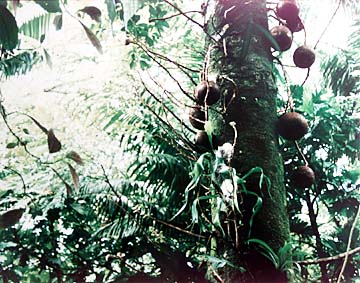
Donnevon Ito of Noelani Elementary captured a scene in the Lyon Arboretum rain forest and called it "Tarzan's Pod."
"What's nice is that it's evolving and continuing," Chun said.
But the duo barely has time to reflect on all that. Right now, they're developing a new environmental project that centers on Manoa Stream and shows the connection of the mountains to the ocean. Again, the project will involve Lyon Arboretum, where students will follow the path of the stream down to the ocean.
"Teaching 'malama o ka aina,' the stewardship of plants and animals, is not something that can be taught through a textbook. The children must be able to see and touch," Nishiki said.

Zara Rabinko of Manoa School painted a watercolor based on one of her snapshots.
"When children go to a place like the arboretum, they develop a sensitivity for nature, and they keep it with them. It's a place where they can learn connections. And children base their real-life connections on the ones they learned in school."
Click for online
calendars and events.